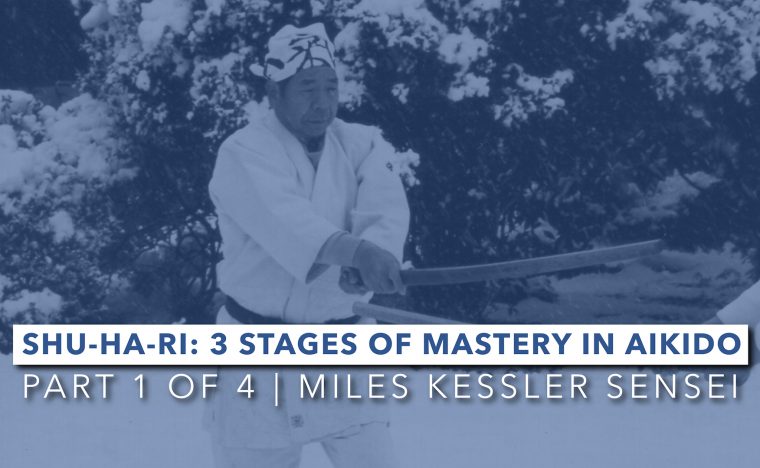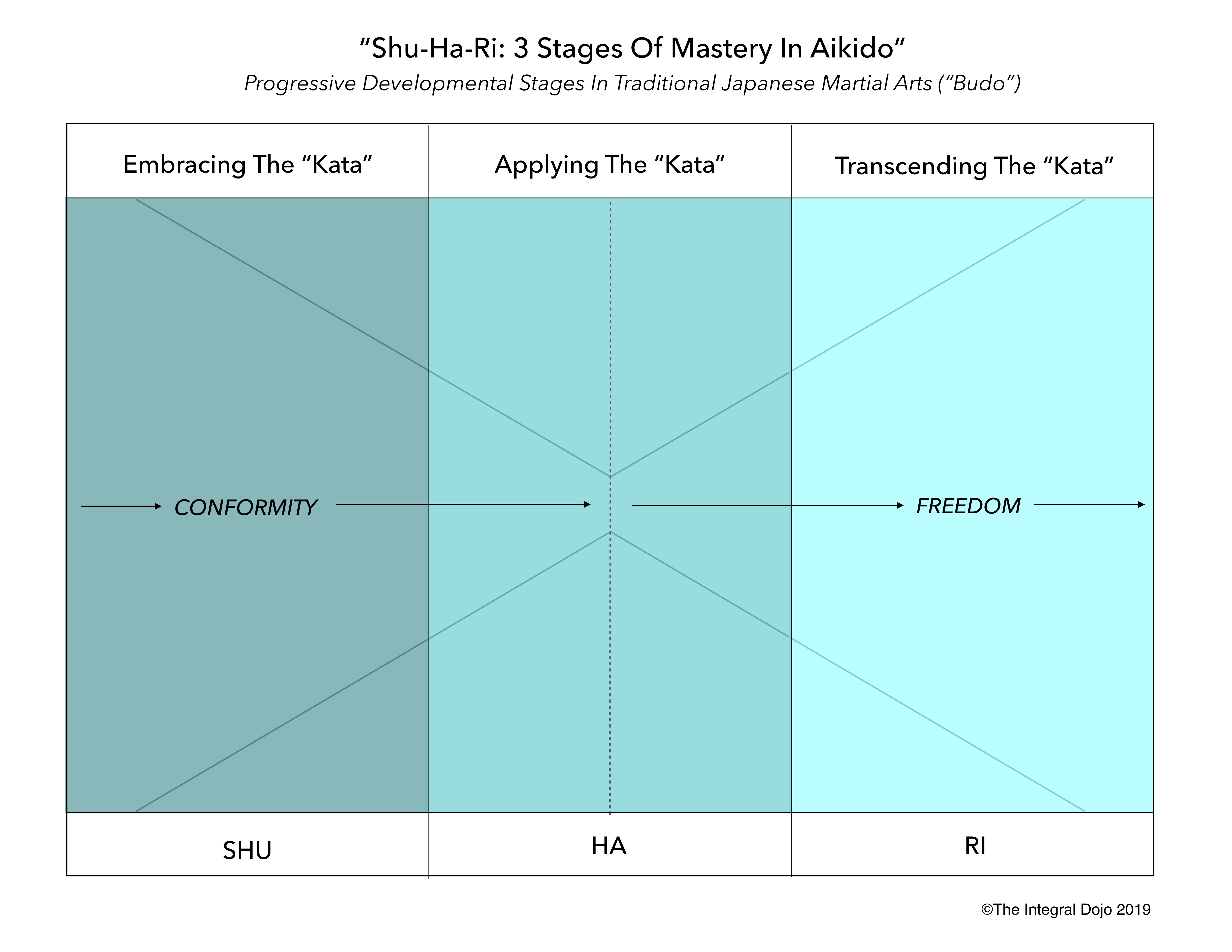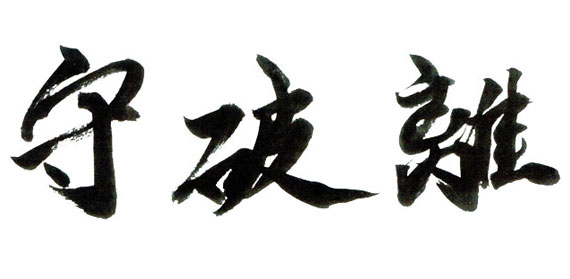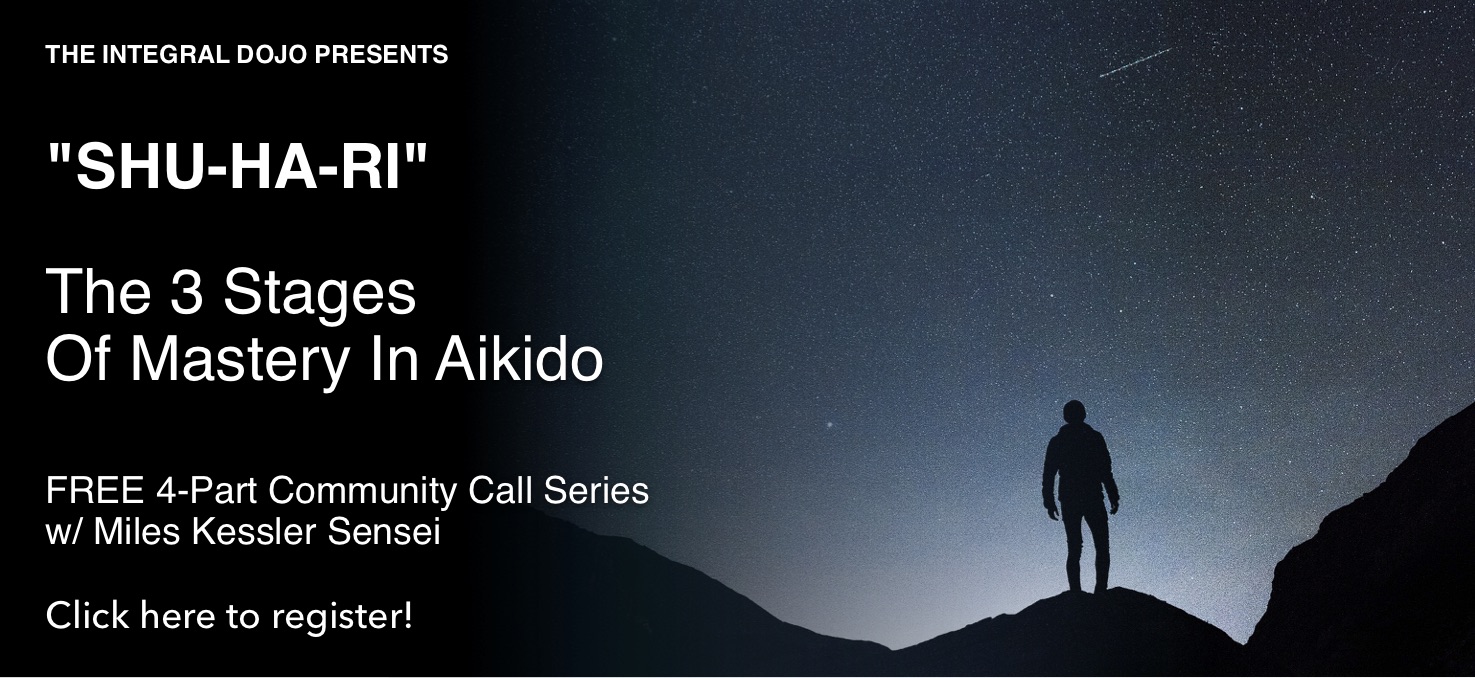What does it mean to create mastery in Aikido? Does mastery mean you are an untouchable fighting machine who’s better faster and stronger than everyone else? Or you are able to resolve any conflict that you meet in life, or that you have the demeanor of a Zen master? Let’s take a look at these questions through the lens of the traditional Japanese system of Shu-Ha-Ri: 3 Stages Of Mastery In Aikido.

What Is Shu-Ha-Ri?
Shu-Ha-Ri is the 3 stages of mastery that comes out of the traditional Japanese arts and the “old school” apprenticeship systems. Western apprenticeship systems also had similar stages, but Shu-Ha-Ri is especially unique in the Japanese arts because of the high degree of conformity in Japanese culture.
However, even though Shu-Ha-Ri is a learning system, it is also a reflection of the natural learning process one goes through during any kind of apprenticeship studies. Pascal Krieger, Jodo teacher and author of the classic book “Way Of The Stick”, says “Shu-Ha-Ri is a natural cycle of apprenticeship, practice, and mastery.”
By living, working, and practicing by a master’s side, over several years the apprentice will gradually gain the wealth of knowledge of the master. The apprentice learns how to unlock the secrets of the art, gradually becoming a creative master in their own right, and in turn adds new knowledge to the art.
“The Ladder Of Development” – Adult Psychological Growth
The stages of Shu-Ha-Ri are quite literally like climbing the rungs of a ladder, with each rung being the necessary step in order to ascend to the next rung. In other words, your current stage of development is the necessary foundation for you to progress to the next stage of development. Each and every stage needs to be mastered by itself, with higher levels being a living expression of mastery of the art.
But Shu-Ha-Ri’s vertical growth is not simply about creating technical proficiency, or mastery in certain skillsets. Shu-Ha-Ri done right is actually a vehicle to help you to mature psychologically. Moving from one stage to the next requires that you go beyond limited “ego-centric” ways of being, and develop the capacity to take more and more perspectives. Over time you will actually have a more complex world view and the capacity to take more perspectives.
In Shu-Ha-Ri, you will grow and mature as a human being with each developmental stage. Because you’ve developed the ability to take multiple perspectives, you will have an increased capacity for care and compassion for others. There is always a trans-personal quality to mastery. In other words, less ego, more free expression of the art. Gaining martial skill without psychological development is not Shu-Ha-Ri.
The 3 stages of Shu-Ha-Ri are:
- “SHU” – Conform to the kata
- “HA” – Apply or adapt the kata
- “RI” – Transcend the kata
*”Kata” = Form
Stage 1: “Shu” – Conforming To The Kata
Shu-Ha-Ri begins where all apprenticeships begin, with diligent adherence and conformity to the forms and teachings of the school, and tradition. In martial arts, this could be simplified to “Conforming To The Kata.”
This is the conformity stage where one commits to following a teacher, school, and/or tradition. In the Shu stage, you will undertake a “prescriptive” practice, following precisely as possible your teacher’s instructions. It is your job as a student to learn, diligently repeat, and perfect the basics, without variation, or innovation. Any personal style is not allowed at this stage… because it is too soon.
Strict adherence to the forms and methods is a must, with the basic requirement of submission to the teacher and ways of the school. This is the stage where your ego is put second, and the practice is put first (and everything is practice). Through your training, you will become a photocopy of the style and it is clear to the trained eye which teacher and school you belong to.
In the Shu stage, not only are you expected to conform to the tradition but in many cases, you are also expected to protect and preserve the techniques and ways of the school. Strict adherence to the forms is expected of you and zero tolerance for free expression. This is simply because it is only through strict adherence to the forms that skill and effectiveness are gradually developed.
Even though you begin to access the inner principles in the Shu stage, the development of the technical forms is the primary focus. Free expression of the principles is given very little importance at this stage.
The main focus of practice is to have a solid grounding in the technical style and a lot of experience in repetitive training. Little to no attention is given towards practical experience outside of those forms at the Shu stage.
Traditionally, the time spent in the Shu stage is 3 to 5 years of training. In the modern times that we live in where you may train twice a week on average, it’s more like 5 to 10 years.
Fixation and the “shadow” of the Shu stage
The first stage of Shu is meant to be a well-established foundation for higher development in the art. However, there is always the danger that your development becomes arrested and you get stuck or fixated at this stage.
This fixation could be your own misunderstanding of development, or it could be because of the teacher, or the school, or the tradition. You are actually taught to be stuck, and you have neither method or process to move you to the next stage.
Whatever the case may be, getting stuck in the “Shu” stage will create some very unhealthy “shadow” elements to your practice that become problematic for further development. Some ways the shadow fixation of this stage appears in Aikido (or any other traditional art) is that absolutism and dogmatism sneak into the system.
Whenever you hear a narrative along the lines of “We must preserve the true way!”, or “We are doing the real Aikido”, or “All others are lost on the Path”, then you can be sure that you are hearing the fixated “shadow” of this first stage.
Other ways the shadow can manifest at Shu is because of your attachment to what is right and wrong, you become rather rigid and stubborn, which manifests in your Aikido. You can also be quite judgemental of other students, other schools, and other teachers.
The result of these shadow aspects is a closed mind and no openness for further learning.
However, if you are practicing in a context that is not fixated but rather developmental, then your upward development will naturally proceed to the next level… namely, “Ha”.
Shu-Ha-Ri
Stage 2: “Ha” – Applying The Kata
When the “Shu” stage of development reaches its culmination, you will naturally move into the next stage. If you don’t make this move on your own, then your teacher will begin to nudge you into the next stage. Ha means to separate, detach, or break the forms of the teacher, the school, and the tradition. This is the “application stage.”
The Shu stage has given you much experience in your art, but almost always in very clearly controlled conditions. Now in the Ha stage for you to continue to develop you will need to open up those conditions and begin to apply what you know in new and as yet unknown ways.
It is as if you have one foot firmly planted in the basics as your foundation, and the other foot starts to explore into the unknown. In fact, at this point ideally, your teacher will begin to move you out of the basic forms and have you apply what you know to more complex situations.
The Ha stage is full of trial and error, and a lot of disappointments. But also you will gain new confidence in each “win”. It is as if you have learned a mathematical formula in the classroom… now you need to go out and face the challenge of building a bridge with that formula.
Prescriptive vs. Self-Authoring
The training in the Ha stage is half prescriptive, where you follow the basics of the art and your teacher’s instructions. The other half of the training is self-authoring, where you learn through trial and error what is the more effective expression of the art for yourself. If your training is ineffective, then you necessarily revert back to basics. When you discover a new and effective application then you will move forward and deepen it.
Whatever the case, you will constantly move into new experiences where you need to prove yourself again and again. Each new “win” is a deeper understanding and you will begin to develop greater fluency and proficiency of the art. This is done by moving from the Shu foundation and starting to develop more complex variations of the basic forms, as well as new and challenging applications.
The Ha stage requires you to move out of the black and white certainty of the Shu stage, and into ambiguity and the unknown. Through direct experience you will begin to figure out what works and what does not in any given situation. Your values will shift from the “right vs. wrong” mentality of the Shu stage, and into the more open-minded value of “functional effectiveness” at the Ha stage.
This is the beginning of developing your own individual style, even though you are still strongly influenced by your teacher and school. In the Ha stage of development, your art will gradually shift to where the principles become primary, and the forms secondary. In other words, there is a shift from the “forms containing the principles”, to the “forms expressing the principles.” A move from “conformity” and towards “freedom” (more on that in a future post).
In the old Samurai days, this was the time that you would take on “Musha Shugyo”, or austere training without a master. Once the deshi graduated the Shu stage they were expected to wander around the country visiting other dojos, other teachers, and other styles to pit their skills against them. If the Musha Shugyo-sha was better, then he would move on to the next dojo. If he was defeated however, he would then stay on and learn in that school.
Traditionally the Ha stage would take 5 to 15 years of training. In the modern times that we live in where you may train twice a week on average, it’s more like 10 to 20 years.
Fixation and the “shadow” of the Ha stage
Like any developmental stage, the Ha stage also has the possibility of becoming fixated, and should this happen you will start to see some specific unhealthy shadow aspects that can sneak in at this stage.
The Ha stage is characterized by creating complexity, fluency, and proficiency. So it requires that you start to learn complex variations and innovative applications. But if finding the next variation, or wildly complex application becomes your main purpose then you there is a possibility that you will be creating more breadth, but not attaining greater depth to match breadth.
Flashy, complicated, and sensational variations (usually choreographed) can look impressive from the outside. But unless you are gaining further depth and embodying the core principles of the art you will surely plateau at this stage.
Another shadow aspect that can slip in at the Ha stage is a lingering attachment to form. Since at this stage, one foot is in the forms, and one foot is in the principles, there can still be a subtle attachment to the forms. You may place an unhealthy importance on the complete historical progression of the forms, decade by decade, as if it is actual wisdom. When it is simply a repetition of, and holding onto the past that creates a glass ceiling for further development.
The culmination of the Ha stage is having powerful access to the principles of the art and then giving yourself permission to let go of the forms altogether. If there is still a subtle attachment to the forms then you will never give yourself this permission. If this is the case then you will never discover the power of spontaneous creativity that is waiting for you at the next stage.
If these shadow aspects are present in your Aikido then you will be stuck in repeating endlessly wild variations, but no capacity to spontaneously express a free application of the art. Essentially your Aikido will be broad, but not deep… complicated, but not spontainiously creative.
COME AND PRACTICE SHU-HA-RI AT
THE WINTER AIKIDO CAMP
A 5-DAY INTENSIVE IN TEL AVIV, ISRAEL
Stage 3: “Ri” – Transcend The Kata
When the Ha stage comes to its full maturity, the Ri stage will begin to manifest naturally. As you perfect the practice of applications, you will quite literally liberate the principles from the forms.
Ri means to “transcend the forms”, and this is the stage where you go beyond the techniques and even the need for the teacher, the style, and the tradition. Even though Ri is the stage of “discarding the kata”, you don’t discard the forms because they are no longer useful. You are fully aware they are the vehicle that brought you to where you are, so you have total respect for the kata.
Rather you go beyond the forms simply because you have completely internalized the forms and are no longer reliant upon them. The principles become the primary source of your art and your Aikido is a natural expression of those principles.
Of course, this does not mean that you no longer respect the forms, because you do. In fact, it is this stage that has the greatest respect for the forms, because it is this perspective that has the deepest understanding of the forms. You are completely free to spontaneously use the forms of the art based on what is appropriate to the situation.
You now see the forms like the boat that carried you across a river. Once you are on the other side the boat has served its purpose and there is no need to carry the boat forward on your journey. The only reason you would use the boat again (the forms) is if you need to cross another “river”, or to help others to cross the river too.
At the Ri stage you are now a living expression of the art and you have moved out of prescriptive training, and into self-authoring Aikido. You are so grounded in the living dynamic principles of the art that your trust in the process is unshakable.
Creativity has been completely unleashed and you are free to create the art anew. Your Aikido becomes an expression of new techniques, new practices, new teachings, new methods, and new systems. Your creativity will never “spoil” the art because what you do is a function of Aikido’s principles.
The art totally becomes your own at this point as you answer to no one. If you are lucky, you will have a teacher who naturally graduates you when you reach this stage. But that isn’t really necessary since having reached this stage you now give yourself permission to be free. Even though you may stay part of the lineage out of loving respect, you are your own authority. In some cases at this point, the student may even surpass the teacher.
Average time of training to establish the Ri stage: lifetime.
Fixation and “shadow” at the Ri stage
The Ri stage of development is truly a transcendent stage. But even though there is a great deal of freedom and creativity at this stage, therein lies the potential shadow. If you fixate at this stage you can actually get stuck in creativity and freedom, and ironically, you may reject the previous structures. You subtlely favor emptiness over form and flow over structure.
Having climbed the ladder of development, you now achieve the stage where you transcend the ladder. You would not be where you are without this developmental system, and yet paradoxically, at this stage, you no longer need this system.
So the shadow move is to then turn around and renounce the two previous stages precisely because they are not spontaneous, free, and creative. The result of this is that the “ladder of development” gets taken out at the knees, and the whole system collapses like a pancake.
Ideally, having fully internalized the 3 stages of Shu-Ha-Ri you will have integrated access to the unique features of each stage. You will be able to fully meet a given situation with what is needed, be it conformity, application, or free expression of the art.
At this point, the step-by-step progression of Shu-Ha-Ri is no longer linear, but rather becomes a continuous cycle of discovery.
In Conclusion
This post on Shu-Ha-Ri is a general overview of this traditional system. It would be a mistake to try to box yourself or others into one stage or another. Since it is quite impossible to evaluate your self to be at any given stage, this overview is meant to offer you an orienting generalization of development for your practice.
Even though Shu-Ha-Ri is a learning method in the traditional apprenticeship system, this ladder of development is a very natural process of transmitting wisdom from one generation to the next.
Modern and Post-Modern teaching methodologies have come a long way since the old-school apprenticeship days. And there have been many wonderful up-grades in educational methodologies. But to totally throw out the baby with the bathwater by leaving this system behind would be a great loss.
The Shu-Ha-Ri system is a powerful vehicle for the transmission of wisdom precisely because it is a natural system. This method of passing the torch of wisdom from one generation to the next is irreplaceable.
Question: How is Shu-Ha-Ri expressed in your school? Or not expressed as the case may be? Leave your comments below!
Check out part 1 of this 4-part video teaching w/ Miles Kessler on Shu-Ha-Ri:
Watch this space for these up-coming posts in this Shu-Ha-Ri series:
- Shu-Ha-Ri: The Ladder Of Development
- The Narrow Gate: Conformity vs. Freedom
- The Discovery Cycle: From Linear To Cyclical Learning
COME AND PRACTICE SHU-HA-RI IN THIS 5-DAY INTENSIVE
WINTER AIKIDO CAMP | TEL AVIV, ISRAEL | MARCH 4th – 8th, 2019
SAVE WITH OUR EARLY BIRD DISCOUNT UNTIL JAN. 31st, 2019
Click Below For Details!











Please note: I reserve the right to delete comments that are offensive or off-topic.